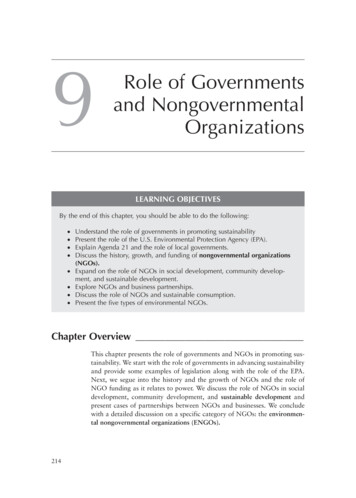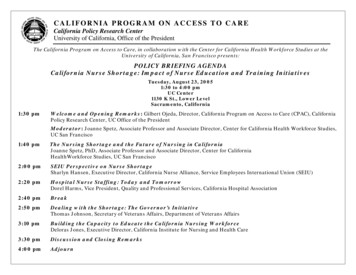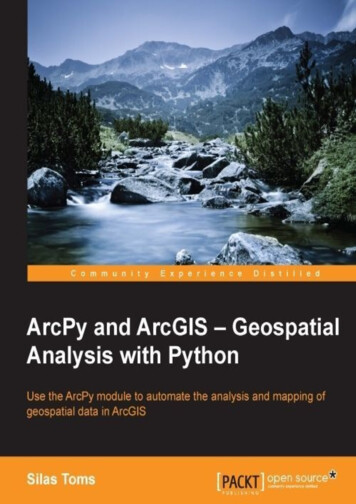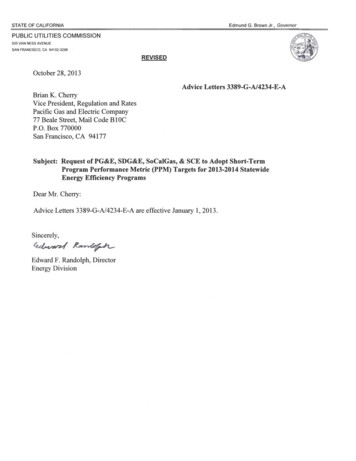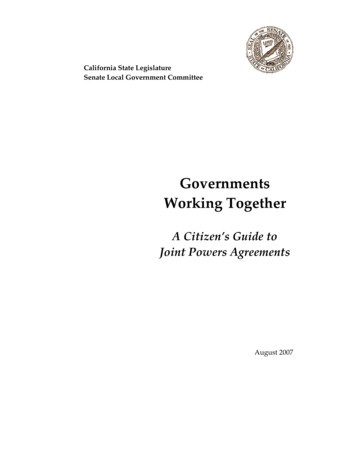
Transcription
California State LegislatureSenate Local Government CommitteeGovernmentsWorking TogetherA Citizen’s Guide toJoint Powers AgreementsAugust 2007
August 2007Dear Reader:For more than 85 years, state law has allowed public agencies to worktogether by signing joint powers agreements (JPAs). Some JPAs arecooperative arrangements among existing agencies, while others createnew, separate institutions called joint powers agencies. These uniqueforms of government affect our daily lives, though many people areunaware of their importance --- or even of their existence.Governments Working Together will help you understand what JPAs do.Becoming familiar with the JPAs in your community can also providevaluable insight into how your governments work --- and provide greatexamples of what your local governments do for you.The Committee appreciates the patient perseverance of Colin Grinnellwho compiled the original research and wrote the early drafts of thiscitizen’s guide which Trish Cypher augmented with additional researchand writing.Respectfully,GLORIA NEGRETE McLEODChair
Senate Local Government CommitteeFor a complete list of the Committee’s Citizen’s Guides, please visit:www.sen.ca.gov/locgov/guides.htm
Governments Working TogetherA Citizen’s Guide to Joint Powers AgreementsBy Trish Cypher and Colin GrinnellAugust 2007
Contents Introduction .3 What Is a JPA?.5 Why Form a JPA? .8 The History of California’s JPAs .10 Statutory Authority of JPAs .11 Types of JPAs.14 The Funding of JPAs .19 JPAs and Special Districts: What Are the Differences?.20 Advantages and Disadvantages of JPAs.22 Current and Emerging Trends.24 Frequently Asked Questions .26 Resources and Web Sites Related to JPAs .29 Acknowledgments .31 Bibliography .32
2
Introduction“Joint powers” is a term used to describe government agenciesthat have agreed to combine their powers and resources to workon their common problems. Joint powers agreements (JPAs) offeranother way for governments to deliver services, but sometimes thepublic does not understand JPAs.This citizen’s guide explains JPAs, outlines their advantages anddisadvantages, and describes how public officials use this specialgovernment arrangement to deliver better services and facilities. Inaddition to deciphering the world of JPAs, this guide provides abetter understanding of how JPAs fit into local and stategovernment operations.3
4
What Is a JPA?Joint powers are exercised when the public officials of two or moreagencies agree to create another legal entity or establish a jointapproach to work on a common problem, fund a project, or act as arepresentative body for a specific activity.Agencies that can exercise joint powers include federal agencies,state departments, counties, cities, special districts, school districts,redevelopment agencies, and even other joint powersorganizations. A California agency can even share joint powerswith an agency in another state.Examples of areas where JPAs are used commonly include:groundwater management, road construction, habitat conservation,airport expansion, redevelopment projects, stadium construction,mental health facilities construction, educational programs,employee benefits services, insurance coverage, and regionaltransportation projects.Even the JPA acronym can mean different things --- joint powersagreement, joint powers agency, and joint powers authority --which may create confusion if people do not use the termscarefully. These descriptions show how widely public officials useJPAs.5
A joint powers agreement (JPA)is a formal, legal agreementbetween two or more publicagencies that share a commonpower and want to jointlyimplement programs, buildfacilities, or deliver services.Officials from those publicagencies formally approve acooperative arrangement.JPA is an acronym usedfor three different terms: Joint powers agreement. Joint powers agency. Joint powers authority.Think about the use of joint powers as a confederation ofgovernments that works together and shares resources for mutualsupport or common actions. The government agencies thatparticipate in joint powers agreements are called member agencies.With a joint powers agreement, a member agency agrees to beresponsible for delivering a service on behalf of the other memberagencies. For example, the City of San José signed a joint powersagreement with Santa Clara County to jointly administerredevelopment funds. San José’s city manager administers theagreement’s terms. In another example, the City of Palo Alto has ajoint powers agreement to provide cable television service to arearesidents, and a Palo Alto city employee administers theagreement.A joint powers agreement is so flexible that it can applyto almost any situation that benefits from public agencies’cooperation.Each joint powers agreement is unique, as there is no set formulafor how governments should use their joint powers. One agencywill administer the terms of the agreement, which may be a shortterm, long-term, or perpetual-service agreement. If a joint powersagreement requires substantial staff time from one member agency,6
but not the others, the managing agency may hire extra staff towork on the joint powers project.The alternative way to exercise joint powers is to create a neworganization that is completely separate from the member agencies.This organization is known as a joint powers agency or jointpowers authority.A joint powers agency or joint powers authority (JPA) is a new,separate government organization created by the member agencies,but is legally independent from them. Like a joint powersagreement (in which one agency administers the terms of theagreement), a joint powers agency shares powers common to themember agencies, and those powers are outlined in the jointpowers agreement.If an agreement’s terms are complex or if one member agencycannot act on behalf of all members, forming a new governmentagency is the answer. This new agency typically has officials fromthe member agencies on its governing board. For example, threelocal governments formed the Belvedere-Tiburon Library Agencyin July 1995 as the legal governing body of a new independentcommunity library. Its seven-member board has three trusteesappointed by the City of Belvedere, three by the Town of Tiburon,and one by the Reed Union School District. This library JPA hasthe same responsibilities as any public agency, including personnel,budgeting, operations, and maintenance.Sometimes public officials establish JPAs specifically to arrangecapital financing by selling bonds. These bonds create the capitalneeded to finance construction of public facilities. Public officialssometimes call this type of JPA a joint powers authority or a publicfinancing authority (PFA).7
Public financing authoritiesinclude agencies formed toA joint powers authority (JPA)fund capital projects, such ascan also be called a publicthe Berkeley Joint Powersfinancing authority (PFA).Financing Authority, whichresulted from an agreementbetween the City of Berkeley and the Berkeley RedevelopmentAgency. Bonds issued by this JPA provided the capital to buildpublic facilities and the costs will be paid back over time by theAuthority and from the revenue generated by the projects.Why Form a JPA?Why would a public agency enter into a joint powers agreement orform a joint powers agency? JPAs exist for many reasons, whetherit’s to expand a regional wastewater treatment plant, providepublic safety planning, set up an emergency dispatch center, orfinance a new county jail. By sharing resources and combiningservices, the member agencies --- and their taxpayers --- save timeand money.The Marin County Hazardous and Solid Waste ManagementAuthority is an example of a cost-saving JPA. It provides garbageand recycling collection and household hazardous-waste disposalservice to residents of 12 cities and towns and the unincorporatedareas of Marin County. In fact, many solid waste JPAs (known asregional waste management authorities) show the efficiency of jointpowers arrangements.8
Officials create JPAs to: Cut costs. Be more efficient. Reduce (or eliminate)overlapping services. Share resources.All levels of government use JPAs totackle common problems. TheNorth Coast Emergency MedicalServices JPA provides emergencymedical services to the residents ofDel Norte, Humboldt, and Lakecounties. These counties pooledtheir resources and purchasedequipment that the member agenciesnow share.Federal and state agencies also join JPAs. The Santa MonicaMountains Conservancy (a state agency formed in 1979 to acquireopen space in the Santa Monica Mountains) and the cities of Brea,Diamond Bar, La Habra Heights, and Whittier are members of theJPA called the Wildlife Corridor Conservation Authority.When public officials create a joint powers agency, the neworganization may not necessarily include “joint powers” or “JPA”in its name. Yet, if a public organization relies on a joint powersagreement, the organization is a JPA, regardless of its title. JPAsare not special districts, redevelopment agencies, or nonprofitcorporations, although these agencies can enter into joint powersagreements.Among the terms found in JPAs’ official names are: agency ·alliance · association · authority · board · bureau · center ·coalition · commission · committee · consortium · cooperative ·council · district · facility · fund · group · institute · JPA ·league · network · organization · partnership · patrol · plan ·pool · program · project · region· service · services · source ·study · system · trust · zone.9
The History of California’s JPAsThe concept of allowing public agencies to share powers started inthe 1920s, when tuberculosis was a serious public health threat inthe Bay Area. San Francisco officials lacked adequate facilities totreat tuberculosis patients and the city’s damp, chilly weather wasnot favorable to their recovery. Just across the Bay, AlamedaCounty had a more favorable climate and a tuberculosissanitarium, but Alameda’s facility did not have enough room forSan Francisco’s patients. This predicament created an opportunityfor San Francisco and Alameda to work together on a solution, butthe counties lacked the legal means.In 1921, Senator M.B. Johnson (R-San Mateo) authored SenateBill 18, which allowed any two cities or counties to enter intoagreements and provide funds to exercise a power common toeach. After the bill passed, Alameda County and the City andCounty of San Francisco drafted an agreement to share theirresources and expand Alameda’s tuberculosis facility. Althoughthis arrangement was controversial, a 1923 California SupremeCourt ruling upheld the new joint powers law.Nearly 20 years later, the Legislature authorized special districts toform JPAs. SB 584 (DeLap, 1941) allowed irrigation districts toconstruct bridges and water projects in the Central Valley withfunding from their respective counties. A few years after that, theLegislature allowed the federal government and state agencies toenter into JPAs with California counties, cities, and special districts(SB 468, Salsman, 1943). Then, in 1947, the Legislature paved theway for the creation of a separate government agency --- a jointpowers agency --- to operate independently of its member agencies(AB 1573, Allen & Evans, 1947).In 1949, the Legislature renumbered and combined these earlierlaws into a unified statute (SB 768, Cunningham, 1949), which alsogave JPAs the ability to incur debt and sell bonds to construct10
public-use buildings, such as exhibition centers, sports coliseums,and associated parking facilities. In 2000, the Legislature formallynamed the law the Joint Exercise of Powers Act (SB 1350, SenateLocal Government Committee, 2000).After California’s voters passed Proposition 13 in 1978, localgovernments saw property tax revenues shrink at the same timetheir population growth boosted demands for facilities andservices. Counties, cities, and special districts had troublefinancing courtrooms, city halls, jails, and other public facilities.The Legislature responded by passing the Marks-Roos Local BondPooling Act (SB 17, Marks, 1985), which allowed local agencies toform JPAs that can sell one large bond and then loan the money tolocal agencies. This practice, known as bond pooling, saves moneyon interest rates and finance charges.Statutory Authority of JPAsGovernments get their authority to work together from a state lawcalled the Joint Exercise of Powers Act.1 JPAs can exercise onlythose powers that are common to their member agencies. Forexample, three fire protection districts and an adjacent city canform a JPA to run a fire department because each member agencyhas the power to run a fire department. However, this same JPAcan’t maintain the local parks because fire districts lack thatstatutory authority.Joint powers agency’s meetings are open to the public and subjectto the Ralph M. Brown Act. Further, JPAs must follow the PublicRecords Act, the Political Reform Act, and other public interestlaws that ensure political transparency.JPAs are different from other forms of government because they arethe only type of government formed by mutual agreement. UnlikeGovernment Code §6500, et seq. To see a copy of the Joint Exercise ofPowers Act, visit a county law library or go to: www.leginfo.ca.gov.111
other governments, JPAs are not formed by signatures on petitions,and they’re not approved by a vote of the people. Public agenciescreate JPAs voluntarily.The formation of a JPA begins when public officials negotiate aformal agreement that spells out the member agencies’ intentions,the powers that they will share, and other mutually acceptableconditions that define the intergovernmental arrangement. Eachmember agency’s governing body then approves the joint powersagreement.For example, if the City of Davis and Yolo County wanted to run acombined library program, the Davis City Council and the YoloCounty Board of Supervisors would approve the JPA. A jointpowers agreement is, in effect, a mutually negotiated documentthat governs and guides the resulting arrangement. Each JPA isunique, reflecting a mutually acceptable agreement among publicagencies that have joined together for a common purpose.If a joint powers agreement creates a new joint powers agency, theJPA must file a Notice of a Joint Powers Agreement with theSecretary of State.2 According to the Secretary of State’s office,approximately 1,800 JPAs have formed a new agency or authority.State officials report receiving about 50 of these notices each year.Until public officials file those documents, a JPA cannot incur anydebts, liabilities, or obligations, or exercise any of its powers.An agreement that creates a new joint powers agency describes thesize, structure, and membership of the JPA’s governing board anddocuments the JPA’s powers and functions. As a legally separatepublic agency, the JPA can sue or be sued, hire staff, obtainfinancing to build public facilities, and manage property. Jointpowers agreements usually protect their member agencies from aJPA’s debts or other liabilities.The public can review JPA documents at the Secretary of State’s special filingunit in Sacramento.212
As a separate agency, a JPA must appoint a treasurer and anauditor. The treasurer may be someone from a member agency, thecounty treasurer where the JPA operates, or a certified publicaccountant who performs the job. The JPA’s auditor must arrangefor an annual audit; many public agencies audit their own JPAs.The JPA must file the completed audit with the county auditor whomakes copies available to the public.JPAs differ from other local governments in another importantway. Before counties, cities, and special districts can issue revenuebonds, they need majority-voter approval. If its voters approve,then the local government sells the revenue bonds to privateinvestors and uses the resulting capital to build a public facility,like a parking garage. As the principal and interest on the bondsbecome due, local officials repay the private investors with therevenues that they collect from, for instance, the new parkinggarage. That’s why this type of public debt is known as a revenuebond.However, a JPA can issue revenue bonds without holding anelection. State law allows a JPA to issue revenue bonds withoutvoter approval, provided that each of the JPA’s member agenciesadopts a separate local ordinance. A city, for example, needsmajority-voter approval to finance the expansion of its sewer plantwith revenue bonds. But if the city and a sanitary district created aJPA, the JPA could issue the revenue bonds without voter approvalif the city council and the district’s board of directors adoptedauthorizing ordinances. While local voters can force referendumelections on these local ordinances, that rarely happens.Special legislation allows some nongovernmental organizations toparticipate in joint powers agreements, even though they aren’tpublic agencies. For instance, to help nonprofit hospitals keep pacewith changes in the health care industry, the Legislature hasallowed them to enter joint powers agreements to provide healthcare services in Contra Costa, Kings, San Diego, and Tularecounties. Another special bill allowed mutual water companies to13
enter joint powers agreements with public water agencies. Andspecific tribal governments have special statutory authority to enterjoint powers agreements.Types of JPAsJPAs perform many functions, although many (but not all) performonly one service.JPAs offer: Public services. Financial services. Insurance pooling andpurchasing discounts. Planning services. Regulatory enforcement.There are no official categoriesfor the types of JPAs, but theirservices fall into five broadgroups: public services, financialservices, insurance pooling andpurchasing discounts, planningservices, and regulatoryenforcement.General ServicesAgencies create JPAs to deliver more cost-effective services,eliminate duplicative efforts, and consolidate services into a singleagency. Counties, cities, and special districts form JPAs to provideservices such as fire and police protection and the removal ofabandoned vehicles. Local agencies also use JPAs to fulfillmandates from the federal and state government, including solidwaste management, special education, regional transportationplanning, and hazardous waste monitoring. Other public servicesprovided by JPAs vary from animal control and data storage toflood control and soil conservation.The Stanislaus Drug Enforcement Agency is a JPA that handlesdrug trafficking by tapping into the expertise and resources of the14
Ceres, Modesto, Newman, Patterson, Riverbank, Turlock, andWaterford police departments and the county sheriff. Before theformation of this JPA, Stanislaus County law enforcement agenciesbattled drug trafficking separately, resulting in disjointed solutionto common problems. The drug dealing in Stanislaus County,especially the methamphetamine trade, continued to escalate.Consolidating the talent, resources, and equipment of each memberagency allowed this JPA to tackle the region’s drug problem moreeffectively. Furthermore, this JPA has been secured federal andstate grants to aid its mission.Humboldt and Del Norte counties and several cities within thosecounties formed the Hazardous Materials Response Authority toprovide a hazardous materials team to oversee a large heavilyforested region. Before creating this JPA, each county and city hadstruggled to operate its own hazardous materials program. TheJPA allows local officials to deliver better services --- and to deliverthem more efficiently. Financial ServicesJPAs use the Revenue Bond Act of 1941 and the Marks-Roos LocalBond Pooling Act of 1985 to generate public capital. Public officialsuse JPAs to finance the construction of public works, includingschools, city halls, bridges, and flood control projects. Some JPAsfinance the purchase of special equipment, such as buses.Financial JPAs with two member agencies, such as a city and itsredevelopment agency, are often called public financing authorities(PFAs) or sometimes captive JPAs. These authorities sell MarksRoos bonds to finance public improvements, like a new jail, localgolf course, or parking lot. The California Debt and InvestmentAdvisory Commission estimates that more than half of all JPAsformed since 1985 issue Marks-Roos Act bonds for publicimprovements.15
The Association of Bay Area Governments is a 107-member JPAthat offers its member agencies financing, such as bond-poolingprograms that finance affordable housing, public works, andconstruction expenses. It is also one of the few JPAs with morethan 100 member agencies.Another large PFA is “CHF,” formerly known as the Rural HomeMortgage Financing Authority, a JPA consisting of most ofCalifornia’s 58 counties. It consolidates federal, state, and localfunding to provide grants and other financing needed by first-timehome buyers. Insurance Pooling and Purchasing DiscountsJPAs offering insurance-pooling and reduced-price purchasingoptions usually involve agencies, such as school districts, that wantto buy insurance or supplies and equipment for their memberagencies. When private insurance companies raised their rates inthe 1970s, many schools withdrew from the commercial insurancemarket and created joint powers agencies to obtain self-insuranceby pooling their funds. These JPAs continue to offer schooldistricts and other public agencies a cost-effective alternative tocommercial insurance. In this arrangement, each member agencyprovides money to the JPA, which controls the funds in a collectiveaccount. The deposited funds earn interest, which finances theJPA’s operations and pays the member agencies’ claims. There aremore than 50 self-insurance joint powers authorities.School districts form JPAs to purchase lower-cost medical anddental benefits for teachers and district employees. The SchoolInsurance Authority, a JPA formed in 1976, includes approximately50 school districts, which together provide insurance coverage toschools throughout the state. Another example is the North BaySchools Insurance Authority, which is comprised of 12 schooldistricts in Napa, Solano, and Yolo counties and provides selfinsurance coverage for property liability and workers’compensation claims. At times, this Authority is even able to16
return money to its member agencies because of “good-risk”performance.The Schools Excess Liability Fund is a JPA made up of other JPAsand therefore can be called a super JPA. This super JPA allowsinsured school districts to pool the insurance assets of their JPAs tohandle claims over 1 million, a practice that provides additionalinsurance coverage above the usual self-insurance policymaximum. The California State Association of Counties operatesthe Excess Insurance Authority, which provides similar insurancecoverage for counties.These super JPAs often securelower rates and better servicesJoint powers agencies thatbecause their large size allows forjoin other JPAs are calledvolume discounts and increasedsuper JPAs.competition among vendors.Some JPAs use their enhancedpurchasing power to buy equipment and supplies from privatevendors. In Mendocino County, for example, several schooldistricts formed a JPA to buy portable classrooms. Planning ServicesCounties and cities also form JPAs for planning purposes and toaddress topics of regional importance. JPAs created for planningreasons typically work on regional problems that go beyond countyand city limits. The JPAs usually bring together experts fromseveral agencies to develop regional or subregional strategies.These JPAs rely on funding from their member agencies and inreturn provide services to their members.More commonly known as Councils of Government (COGs), theseregional planning agencies jointly exercise the planning powers ofcounties and cities. COGs serve most metropolitan regions. TheSouthern California Association of Governments (SCAG) covers sixcounties,187 cities, and more than 18 million people. The17
Association of Bay Area Governments (ABAG) is the joint planningbody for the nine-county San Francisco Bay region. Even ruralgovernments form COGs. The Tri-County Area Planning Councilworks on planning issues for Colusa, Glenn, and Tehama counties.State law relies on COGs to prepare regional housing needsassessments that direct the housing strategies found in county andcity general plans. Many COGs also serve as metropolitanplanning organizations for federal transportation plans. Regulatory EnforcementRegulatory joint powers agreements, the least common type,enforce regulations through an independent agency or as anarrangement with other enforcing agencies. These JPAs ensure thatmember agencies adhere to federal and state laws and proceduresby conducting educational seminars, formulating enforcementprocedures, and maintaining an oversight role. The State ParoleBoard, for example, entered into a JPA with Stanislaus County toassist county sheriffs in monitoring parolees and reporting andapprehending violators.Regulatory JPAs also enforce air pollution regulations. The YoloSolano Air Quality Management District resulted from a 1971 jointpowers agreement to serve as the air-quality regulator for these twocounties. Its governing board consists of Solano and Yolo countysupervisors and the mayors and city council members from thecities within the two counties. This JPA satisfies the legalrequirement placed on all counties to have an air quality regulatoryauthority, and has the same powers to grant air quality variances,monitor air quality, and enforce standards and regulations as itsstate-sponsored equivalent, the Air Pollution Control District.18
The Funding of JPAsAs with any government agency, a joint powers agency needsmoney to operate. Among JPAs there are two popular fundingmethods: (1) create a revenue stream, and (2) raise capital byissuing bonds. Although JPAs do not need voter approval beforeissuing bonds, each member agency must pass an ordinance.Those ordinances face a 30-day period in which voters can objectby signing referendum petitions that trigger an election. If there isno referendum petition or if the petition fails to qualify, the JPA cansell the bonds and use the proceeds to build improvements or buyequipment.The City of El Cajon and San Diego County formed a JPA in 1973 tobuild a new city hall, county services building, and performing artscenter. Their El Cajon Civic Center Authority issued 6.5 million inrevenue bonds to finance the projects, which helped boostdowntown economic development.JPAs that provide financing and sell bonds for multiple agenciespay for their operations by collecting fees from their memberagencies for the JPA’s bond services. Bond transactions arecomplicated and require skilled financial professionals to ensurethat the bond sales meet legal and market requirements. LargeJPAs providing financial assistance hire financial experts and selltheir services to local agencies that want to issue bonds.According to the California Debt and Investment AdvisoryCommission, JPAs have issued 1,238 bonds for securing more than 44.5 billion in debt since 1985.JPAs also sell bonds to refinance their member agencies’ debts.These JPAs will sell a bond and use the proceeds to pay off amember agency’s high-interest debt so it can assume a lowerinterest debt.19
Marks-Roos Act bonds: Do not require voter approval or a referendumbefore a JPA can issue the bonds. Can be issued at a public sale or privately, whichprovides more flexibility in finding a buyer whois best suited for the bond. Can be sold as one large bond with the proceedsloaned to its member agencies, which reducesextra loan fees and other charges.In the 1990s, legislators became worried when a few small citiesused the Marks-Roos Act to issue bonds that exceeded their capitalneeds. As a result, the Legislature stopped the practice of allowingso-called “roving JPAs” to issue bonds to pay for developmentsoutside their member agencies’ jurisdictions (SB 147, Kopp, 1998).JPAs and Special Districts: What Are the Differences?Although sometimes confused with each other, a JPA is not aspecial district, even though they may provide similar services. Aspecial district is a separate local government with its owngoverning body that delivers public services to a particular area.Special districts rely on state laws for their legal authority andelected or appointed boards of directors for their governance. Acomparison of JPAs and special districts appears on the next page.Most special districts provide only a single service to a specificallydefined area, unlike counties and cities that provide servicesthroughout their boundaries. Cities and counties must provide avariety of services, many mandated by federal and stategovernments, whereas special districts deliver only the services thepublic wants and is willing to pay for. Fire protection districts,20
cemetery districts, and mosquito abatement districts exist becausetaxpayers are willing to pay for these
mental health facilities construction, educational programs, employee benefits services, insurance coverage, and regional transportation projects. Even the JPA acronym can mean different things --- joint powers agreement, joint powers agency, and joint powers authority ---which may create confusion if people do not use the terms carefully.



